- Experimental analysis of tungsten carbide ceramic material coated engine using prosopis juliflora methyl ester
S. Kannana,*, S. Mahalingamb and K. Muruganc
aFacutly of Mechanical Engineering, AVS College of Technology, Salem, India – 636106
bFacutly of Mechanical Engineering, Sona College of Technology, Salem, India – 636005
cFacutly of Mechanical Engineering, Mahendra Institute of Technology, Namakkal, India – 637503This article is an open access article distributed under the terms of the Creative Commons Attribution Non-Commercial License (http://creativecommons.org/licenses/by-nc/4.0) which permits unrestricted non-commercial use, distribution, and reproduction in any medium, provided the original work is properly cited.
The study focuses on creating an alternate fuel that will control the increasingly high emission levels of pollutants that affects the environment. Biodiesel has been produced from vegetable seed non - edible oil and also from waste animal fat. They are alternate to the diesel fuel and help in decreasing the import of the crude oil used in diesel engine. The biodiesel extracted from the discarded seeds of Prosopis Juliflora, which are planted in India are used as an alternate fuel as Prosopis Juliflora seed oil with transesterified in Prosopis Juliflora Methyl Ester (PJME). The engine was coated with Tungsten Carbide (WC) Ceramic Material using air plasma spray method. The coating thickness 300 micron for the head of the piston, inlet and exhaust valves are done. The engine performance and emission characteristics of the ceramic coated diesel engine revealed that biodiesel blends of (PJME) results has produced improved brake thermal efficiency and less specific fuel consumption. The emission characteristics are also studied and reported in this work
Keywords: Tungsten carbide, Ceramic material, Thermal barrier coating, Prosopis juliflora methyl Ester, Transesterification process.
The Central Pollution Control Board (CPCB) presently monitored the air quality at 8 locations in New Delhi and reported that the pollution in the air is enormous [1, 2]. The most pollutants such as CO, SO2, NO2, O3 and PM2.5 has the major contributory aspect in release emission out in the atmosphere. The air pollution is caused by the unchecked and unmitigated automobile engine emission levels releasing in the atmospheric air [3]. The generation and usage of biodiesel are used in automobile and several industrial applications [4]. The Prosopis Juliflora Oil (PJO) is used in this research work which (PJO) is non-edible oil, its available from invasive plants spreading throughout the world, and as well as many places of entire Tamil Nadu [5, 6]. The accuracy of the TVI kirlosker engine is very high when compared to the conventional diesel engines. Engine calibration is a process of optimizing engine settings so that optimal engine performance, like minimum fuel consumption, minimum pollutant gas emissions, maximum power output can be achieved. The TVI kirlosker engine with eddy current dynamometer setup connect with PV angle encoder which gives good accuracy of the engine setup.
Prosopis juliflora trees are available in the all over globe in the arid and semi-arid regional areas. The seeds of this tree are dicotyledon in nature and belong to the Fabaceae botanical family and Minosoideae sub-family [7]. Fig. 1 shows the the prosopis juliflora tree and Fig. 2. shows the Prosopis Juliflora seedsm which are 50-250 mm length, 5-15 mm width and 4-8 mm thickness. The tree yields 5 kg to 20 kg/tree and also 2000 kg/ha in a year [8-10]. The Biodiesel transesterification process is carried out to produce non-edible oil involving Prosopis Juliflora seed oil [11]. The Prosopis Juliflora is de-husked and later the oil is extracted from the crushed Prosopis Juliflora seed [12]. The esterified (PJO) was mixed with 5 ml Potassium hydroxide (KOH) and stirred, then the mixture is preheated to the even temperature of 60 oC by heating and the process is done for 1hr 30 min [13]. Methanol or Sodium hydroxide (NaOH) is added to this process and the temperature is maintain at 50 oC and then the mixture is constantly stirred for 2 hr [14]. Finally Free Fatty Acid and Glycerin from this transesterification process are removed [15]. The biodiesel plant is used for the transesterification is shown Fig. 3 and by this transesterification process, Prosopis Juliflora Oil methyl ester (PJME) is prepared as shown in Fig. 4 [16].
Properties of Prosopis Juliflora Methyl Ester
The Prosopis Juliflora Oil methyl ester fuel properties are tested at ASTM standard D6751-02 and it is found to be similar to the diesel and the fuel properties [17]. The fuel property is compared to the neat diesel with PJME and the density at 15 oC of the PJME is similar to diesel and hence PJME is selected for testing the emission and combustion characteristics of the engine in this experiment [18]. The density of the PJME is 874 Kg/m3, flash and fire point of the PJME is 112 oC and 117 oC respectively, and calorific value of the fuel is 39540 KJ/Kg [19]. The evidence of PJME fuel property are compare with the pure diesel and evidence that the properties are very close to the pure diesel and prove that it is an alternative fuel [20]. The PJME was prepared by transesterification process in regulate to blends the used in many different concentrations such as B10, B20, B30, B40 and B50 as shown in Table 1 and these combinations of biodiesel are typically used as a conventional fuel in TV1 kirlosker engine [21].
Thermal Barrier Coating (TBC)
TBC for a thickness of 300 µm ceramic material are insulated in combustion chamber for single cylinder four stroke diesel engine, the piston crown and inlet and exhaust value head by using Air Plasma Spray (APS) coating technique [22]. The thermal barrier coating is performed using the ceramic powder material, Tungsten Carbide (WC) ceramic material as shown in the Fig. 5. The gray color Tungsten Carbide (WC) with a combination of 94% of Tungsten and 4% of Carbide is done on the cylinder parts as shown in Fig. 6 and the coated materials are tested for the properties. The density is found to be 14500 kg/m3, strength is found to be 370 MPa. The melting point is estimated as 2867 oC and thermal conductivity is 110 W/mK [23]. The coating on single cylinder four stroke Direct Injection (DI) diesel engine aims at reducing the emission for the modified TVI kirloskar engine [24].
Methodology
The engine experimental set-up of a TVI Kirlosker single cylinder direct-ignition engine, operating at engine power of 4.86 kW and 1500 rpm is used as the experimental setup for the research work as shown in Fig. 7 and it consists of a eddy current dynamometer connected with electrical loading with PV angle encoder, AVL DiGas 444 model analyzer and AVL 437C model smoke meter [25]. Several researchers investigated the combustion analysis for coated engines in a diesel engine [26, 27]. A water-cooled engine is connected to eddy-current dynamometer link PV angle encoder sensors and engine exhaust manifold with attached AVL DiGas analyzer and AVL 437C smoke meter. The experimental set-up was prepared to reduce the thickness of the piston crown, inlet and exhaust-valve head surface to a 300-μm thickness with a CNC horizontal milling machine. After that the machined component was insulated with tungsten carbide (WC) ceramic material to coat the piston crown, inlet and exhaust valve head surface with a thickness of 300 μm using the plasma spray coating technique. Five biodiesel blend samples are tested for each composition to prove the consistency in results.
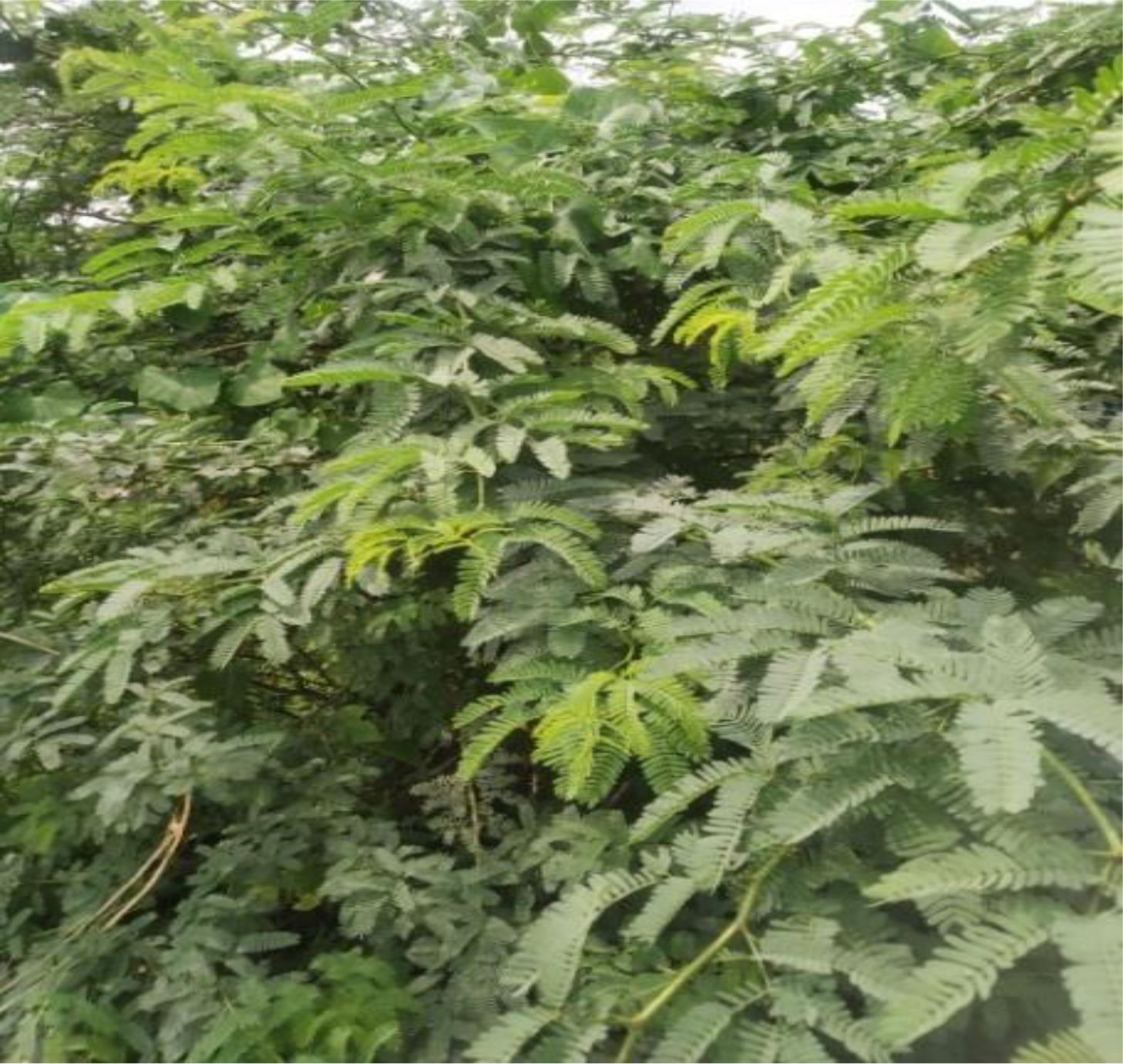
|
Fig. 1 Prosopis Juliflora tree. |
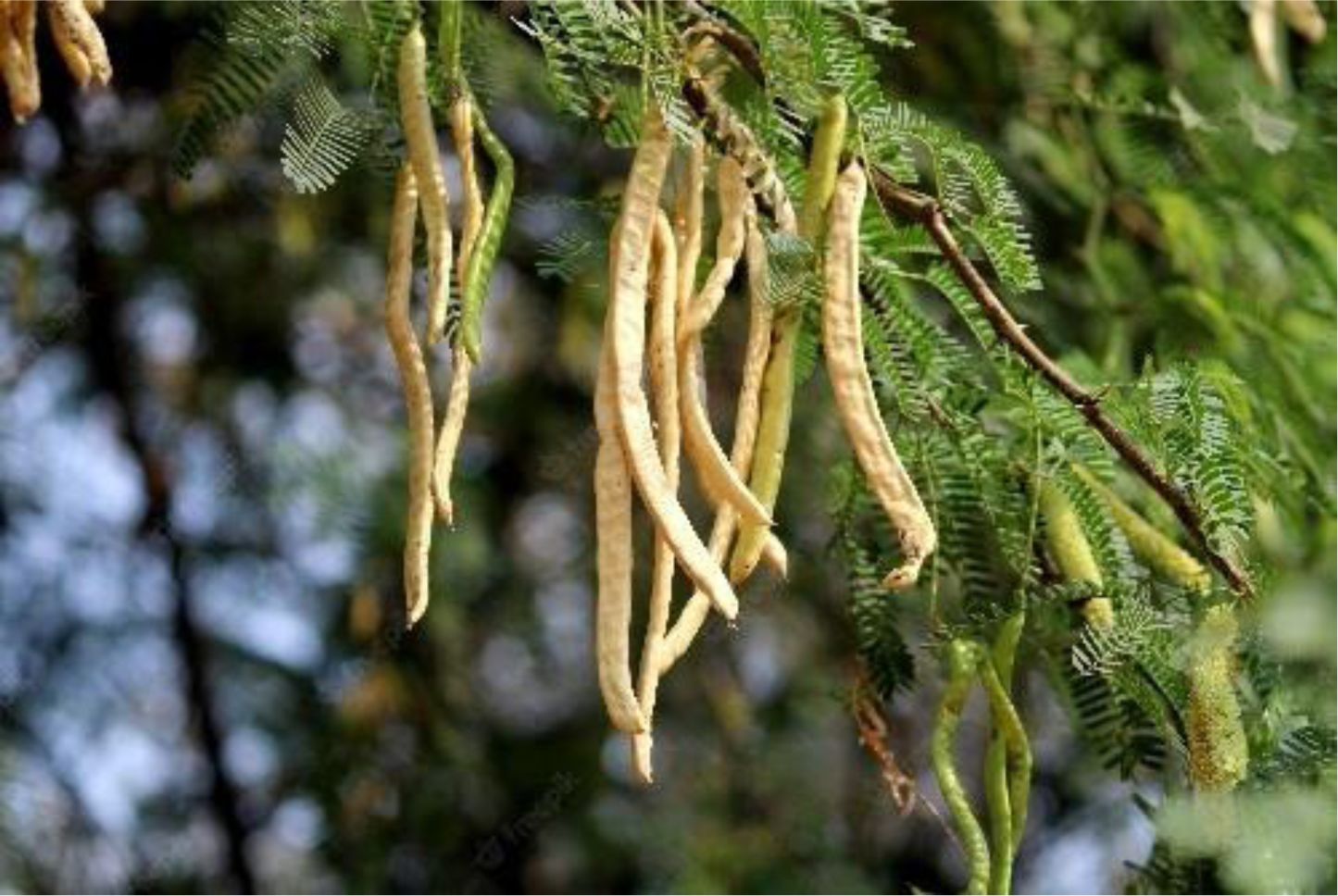
|
Fig. 2 Prosopis Juliflora Seed. |
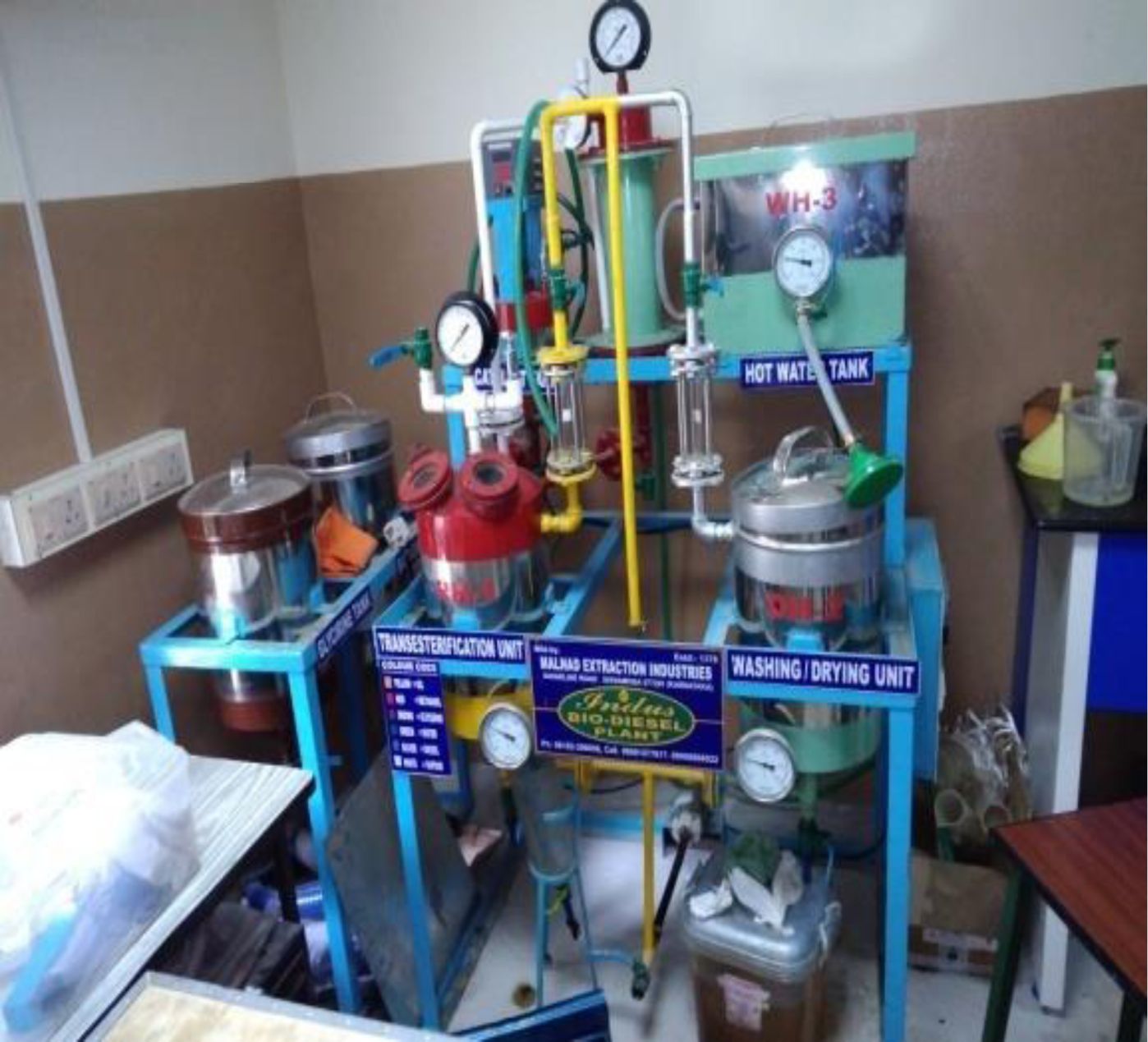
|
Fig. 3 Biodiesel Transesterification Plant |
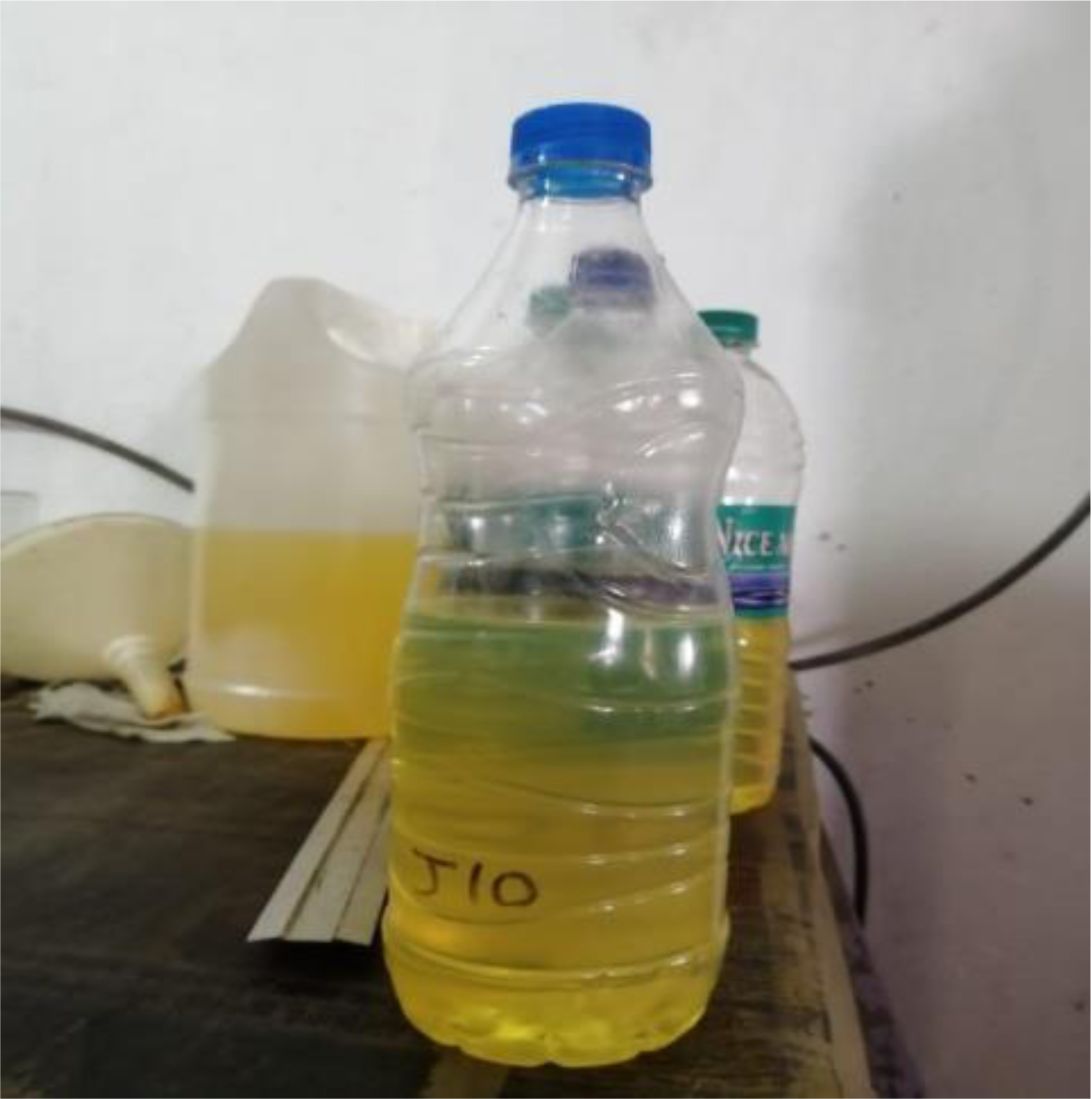
|
Fig. 4 Prosopis Juliflora Biodiesel |
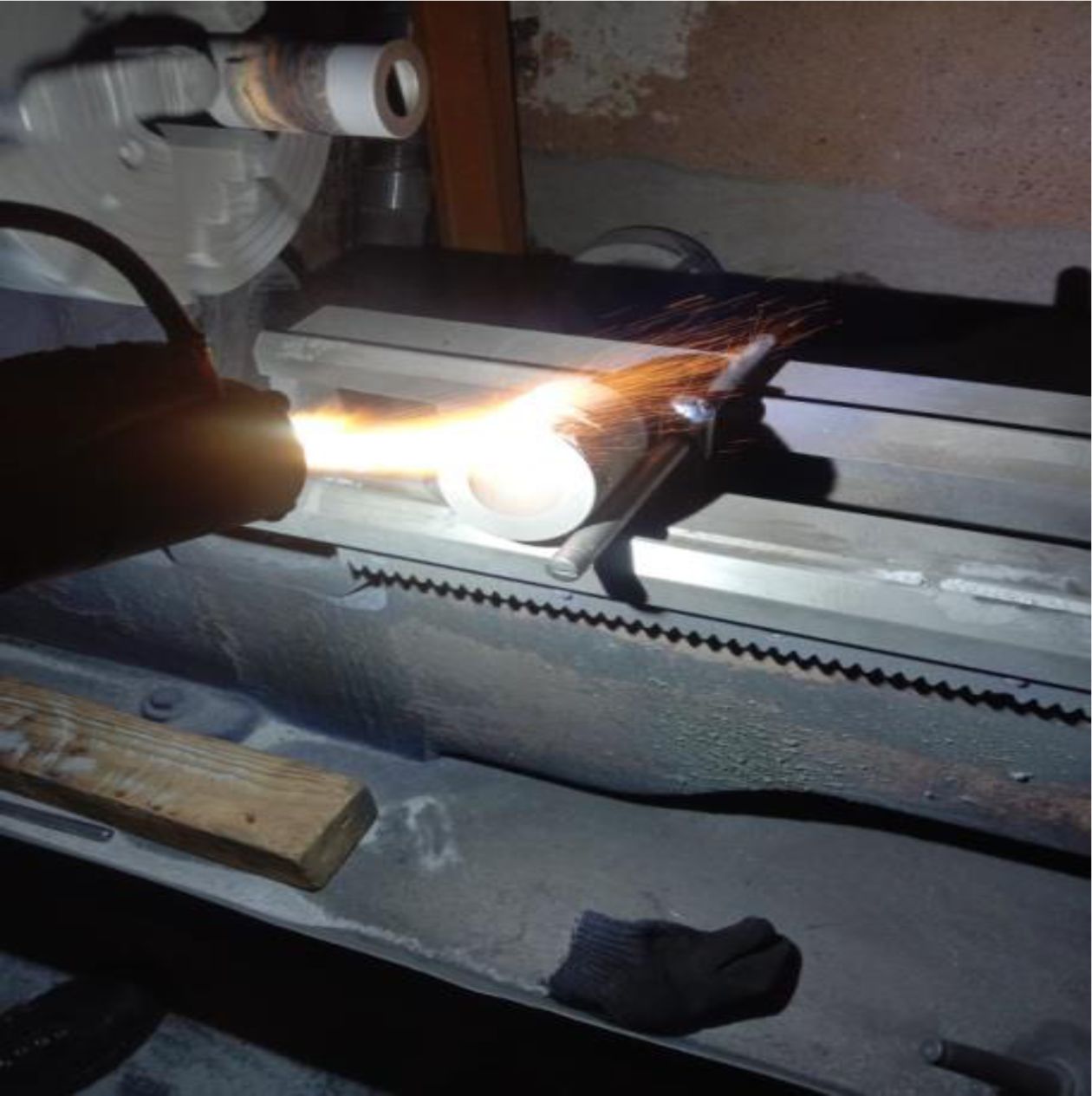
|
Fig. 5 WC Thermal Barrier Coating |
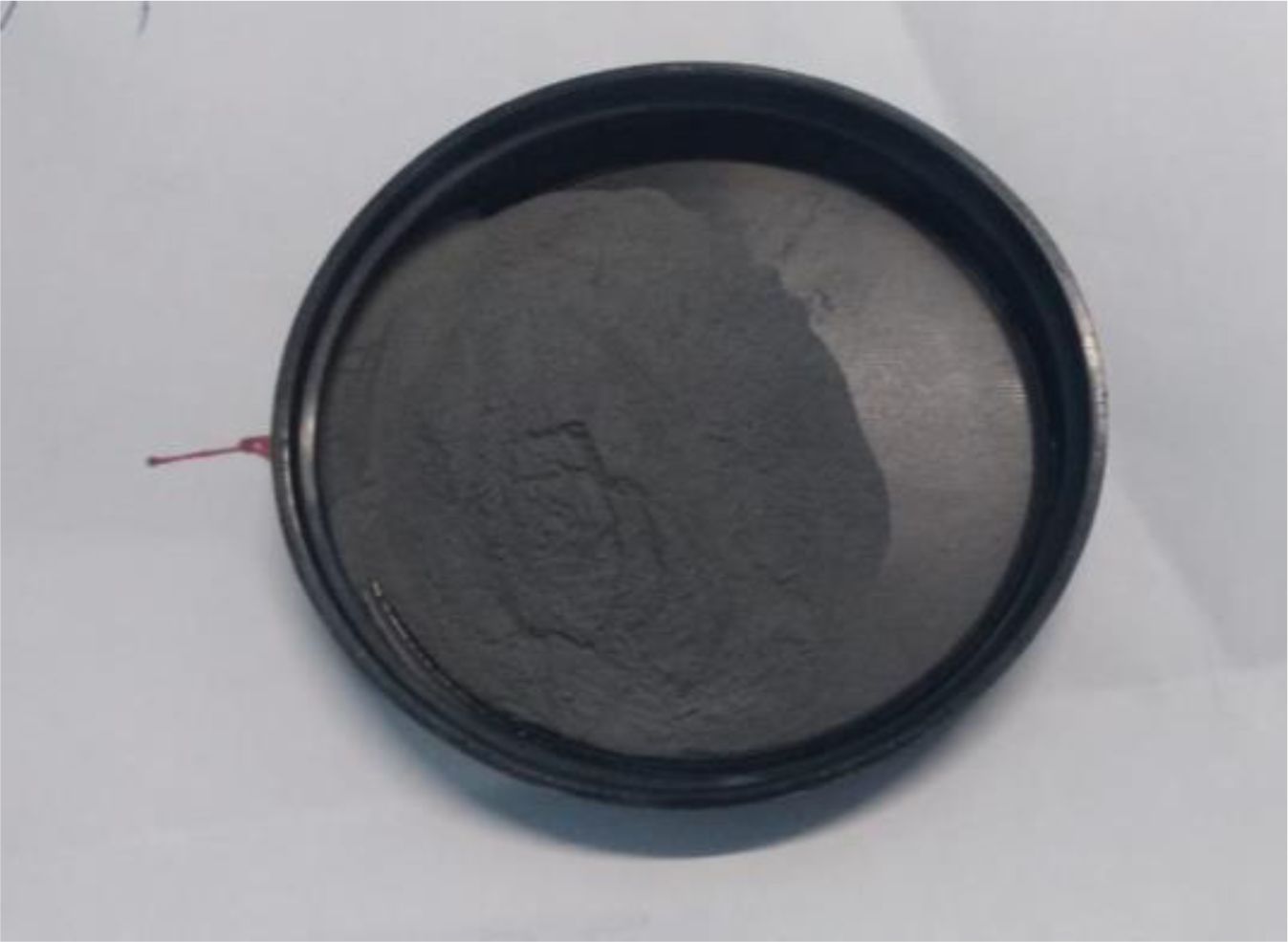
|
Fig. 6 WC Ceramic Material. |
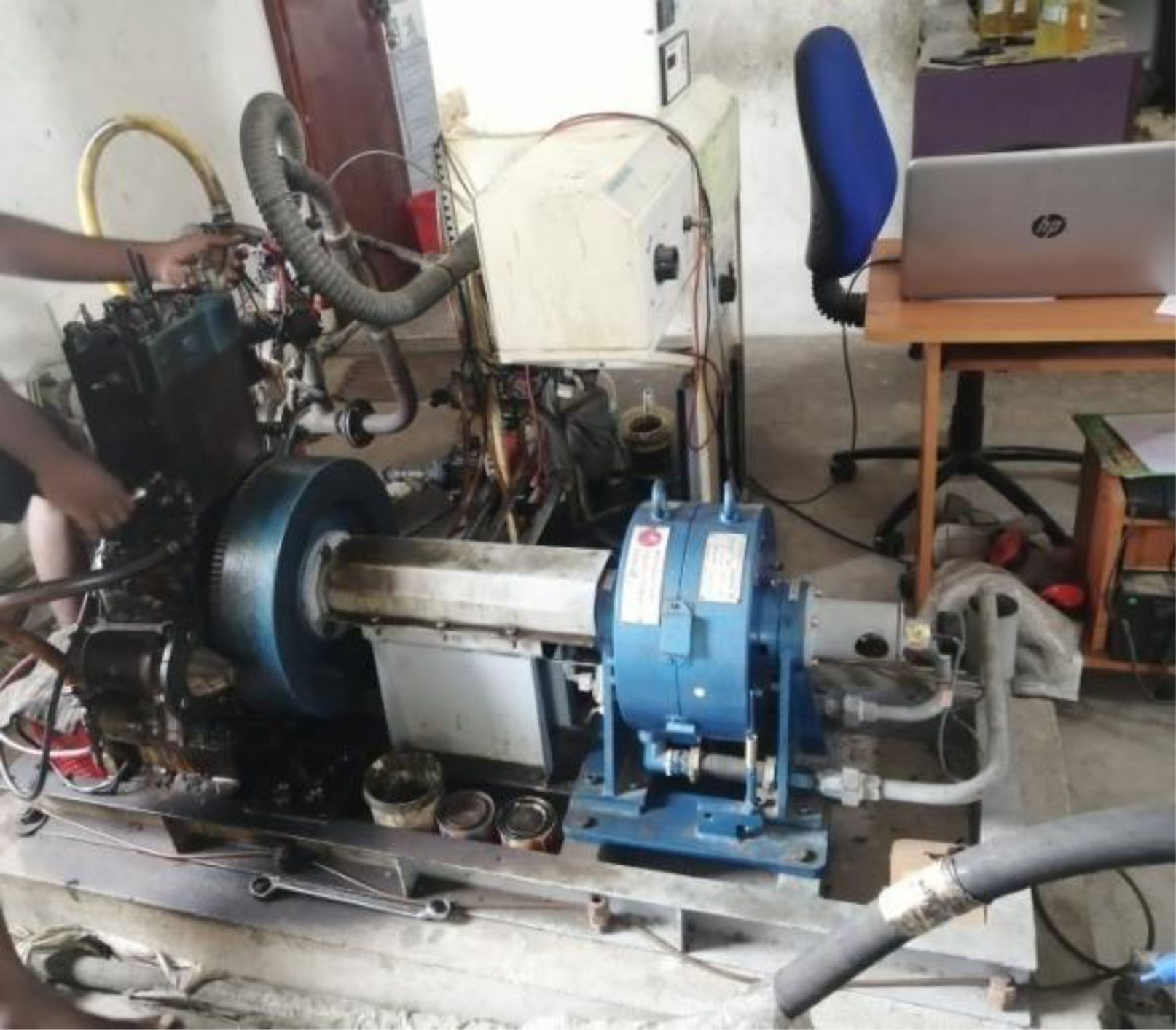
|
Fig. 7 Engine experimental setup |
The experimental results depict the engine performance and emission characteristics level of the ceramic coated diesel engine fuelled with the Biodiesel. The results are compared for the engine performance for tungsten carbide (WC) ceramic material coated engine fuelled with transesterified biodiesel blends of PJME and conventional diesel. The tested engine was running at 1500 rpm constant speed. The engine performance characteristics like as brake power, brake thermal efficiency, fuel consumption, and the emission characteristics such as carbon monoxide (CO), nitrous oxide (NOx), hydro carbon (HC), and engine smoke opacity were analyzed.
Engine performance parameter
The engine brake power at several loading conditions such as unload condition, 25%, 50%, 75% and full load are evaluated for the diesel engine. The tungsten carbide (WC) ceramic material coated diesel engine fuelled with blended PJME biodiesel is analysed. It is eminent that as the engine loading raises, the brake thermal efficiency increases due to higher calorific value of the conventional diesel. Fig. 8. explains the brake thermal efficiency of the diesel engine fuelled during PJME biodiesel blends. The BTE for B10 is 31.87% a whereas it is 32.58% for WC coated engine at maximum engine load conditions.
The volumetric efficiency is calculated for the diesel engine and tungsten carbide (WC) ceramic material coated diesel engine fuelled with blended PJME biodiesel blends and conventional diesel as shown in Fig. 9. It is experiential that the volumetric efficiency during the initial load conditions is higher. The volumetric efficiency is gradually decreases with increase in brake power. The higher value of the volumetric efficiency for the diesel engine tungsten carbide (WC) ceramic material coated diesel engine fuelled with blended PJME biodiesel blends is initiated to be 82.45% at no load conditions where as the volumetric efficiency for the diesel engine fuelled with at same operating conditions is 82.41%. The Fig. 10 describes the BSFC for the diesel engine coated with tungsten carbide (WC) ceramic material and fuelled with blends PJME biodiesel blends and pure diesel. The BSFC intended for PJME fuel estimated as 0.27 gm/kWh whereas the BSFC for diesel fuel operated same load conditions is 0.25 gm/kWh.
Emission Characteristics and Combustion Analysis
The CO emission is analyzed for the diesel engine fuelled with pure diesel and PJME and it is reported in the Fig. 11. It is found that the CO emission for the coated diesel engine fuel with PJME blends and diesel are 32.5 and 28.3% respectively. The CO emission increases with increase in brake power. The Hydrocarbon emission is investigated for the coated diesel engine fuelled with PJME blends and diesel and it is reported in the Fig. 12. HC emission is found to be 70, 65 and 76 ppm respectively for diesel engine operating under the engine conditions. The hydrocarbon increases with increasing load and as a result rich air fuel mixture is burned and produces more hydrocarbon due to lack of incomplete combustion. The nitrogen oxide emission is investigated for the insulated diesel engine fuelled with PJME, and pure diesel and it is illustrated in Fig. 13. It is observed that the nitrogen oxide emission is 1544, 1779 and 1811 ppm respectively for diesel engine operating condition. The nitrogen oxide emission increases with increase into brake power for all the fuel and it is reported that the nitrogen oxide emission for diesel engine fuelled with PJME for full load conditions is 1585 ppm whereas the nitrogen oxide emission for the diesel engine for full loading condition is 1779. The emission of NOx is minimum for PJME fuel while compared to the diesel and the highest value of nitrogen oxide emission is noted at full loading condition. The engine smoke opacity is investigated and proposed for coated (WC) engine and PJME blends is mention in Fig. 14. The smoke opacity for coated engine fuelled with diesel engine and PJME are observed as 66.4, 64.7 and 63.3% respectively. It is seen that the smoke opacity is higher for the diesel engine fueled with and low for diesel fuel.
In combustion analysis, cylinder pressure, heat release rate, ignition delay, and combustion duration were analyzed. In CI engine during the combustion process the fuel is injected using fuel injection jets at very high velocity and the fuel gets atomized. The cylinder pressure is found to be rated 48.01 bar at 7o degrees crank angle for diesel, show in the Fig. 15. The accuracy of the Heat Release Rate (HRR) model depends on the ratio of specific heats. The ignition delay for full load is at 7o degrees Crank angle at the cylinder temperature will be high and the Fig. 16 measures the injection of fuel mixtures, which is at 50-69o (degree) crank angle.
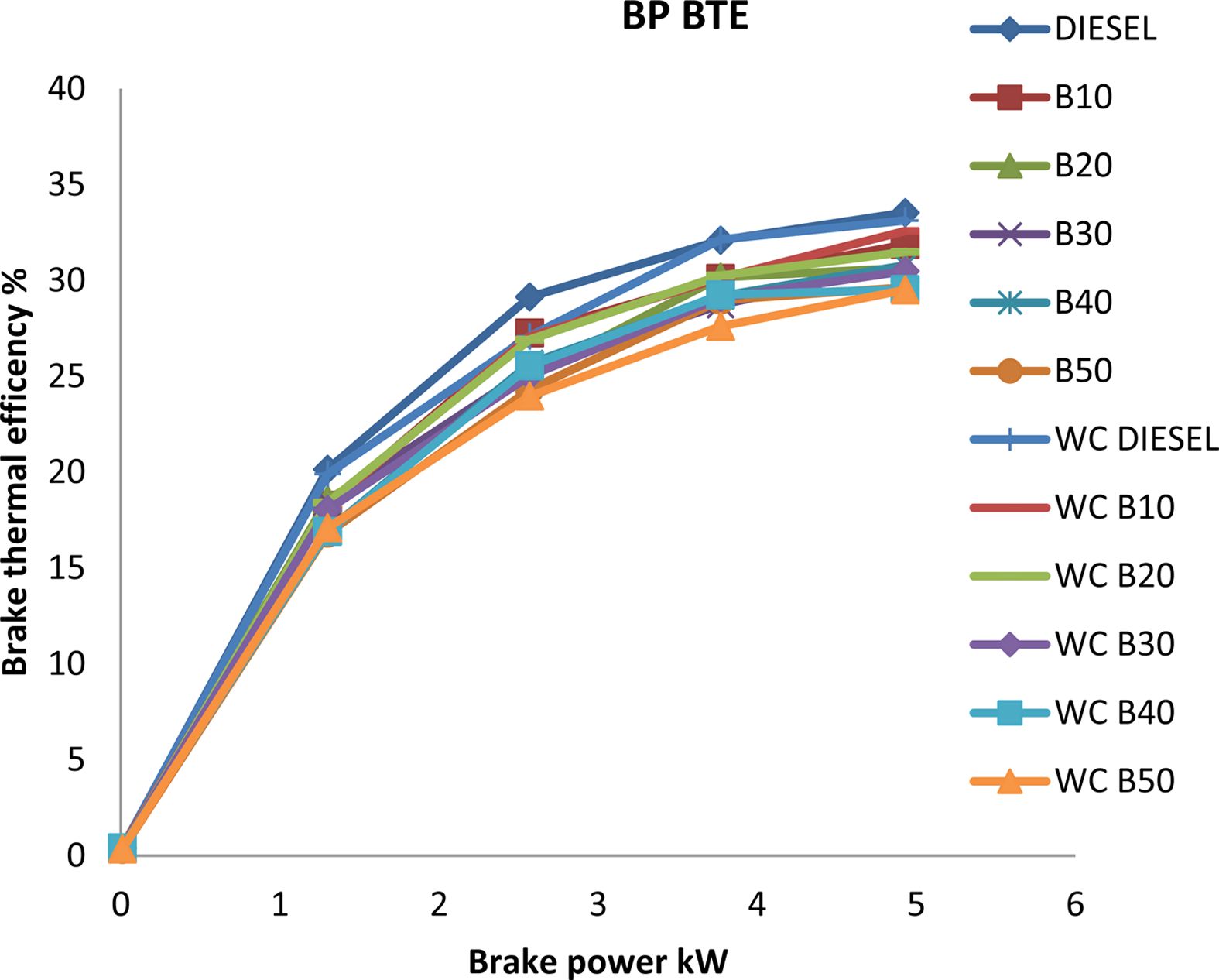
|
Fig. 8 Comparison of BTE fuelled vs BP. |
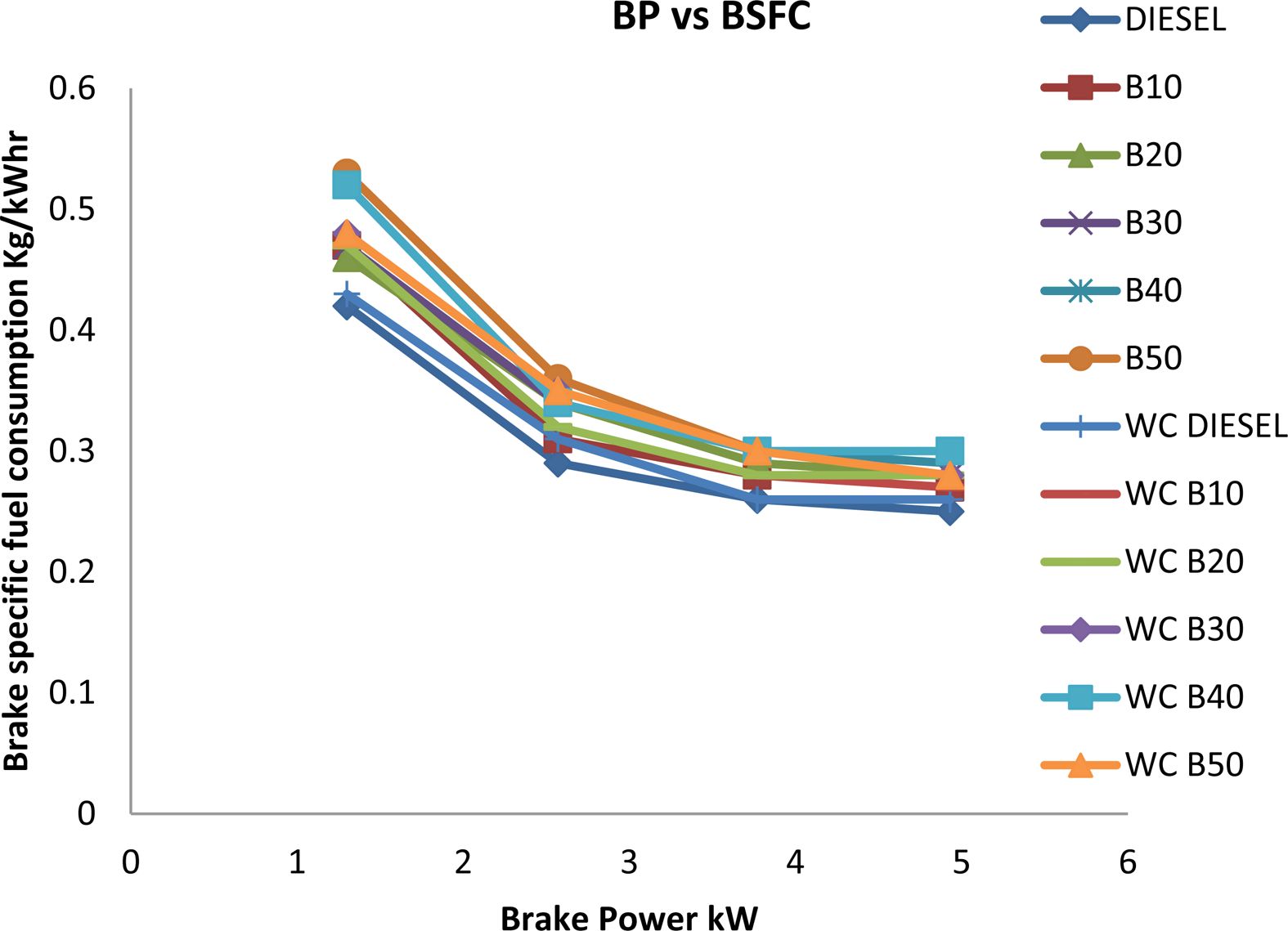
|
Fig. 9 Comparison of Vol ɳ vs BP. |
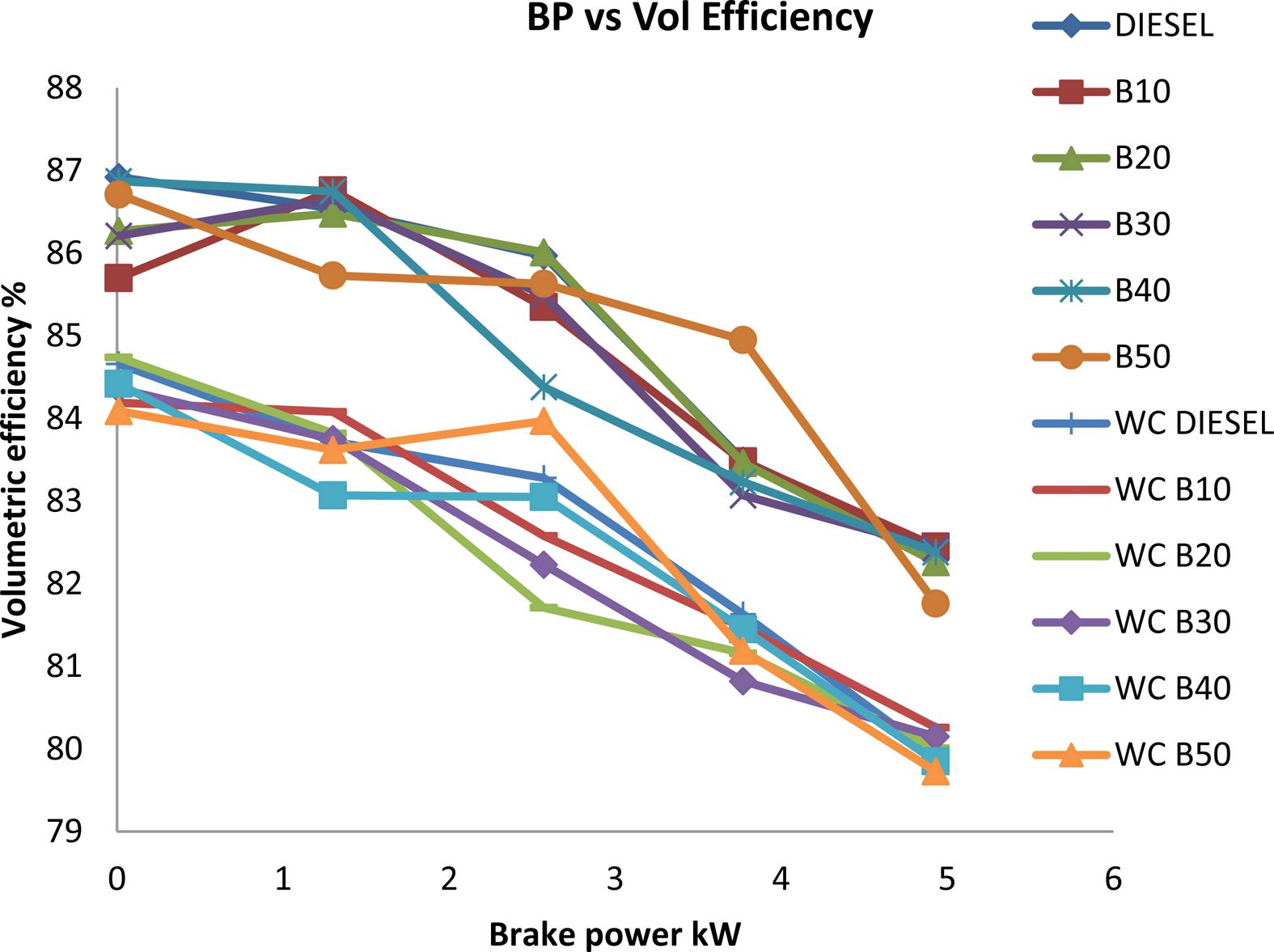
|
Fig. 10 Comparison of BSFC vs BP. |
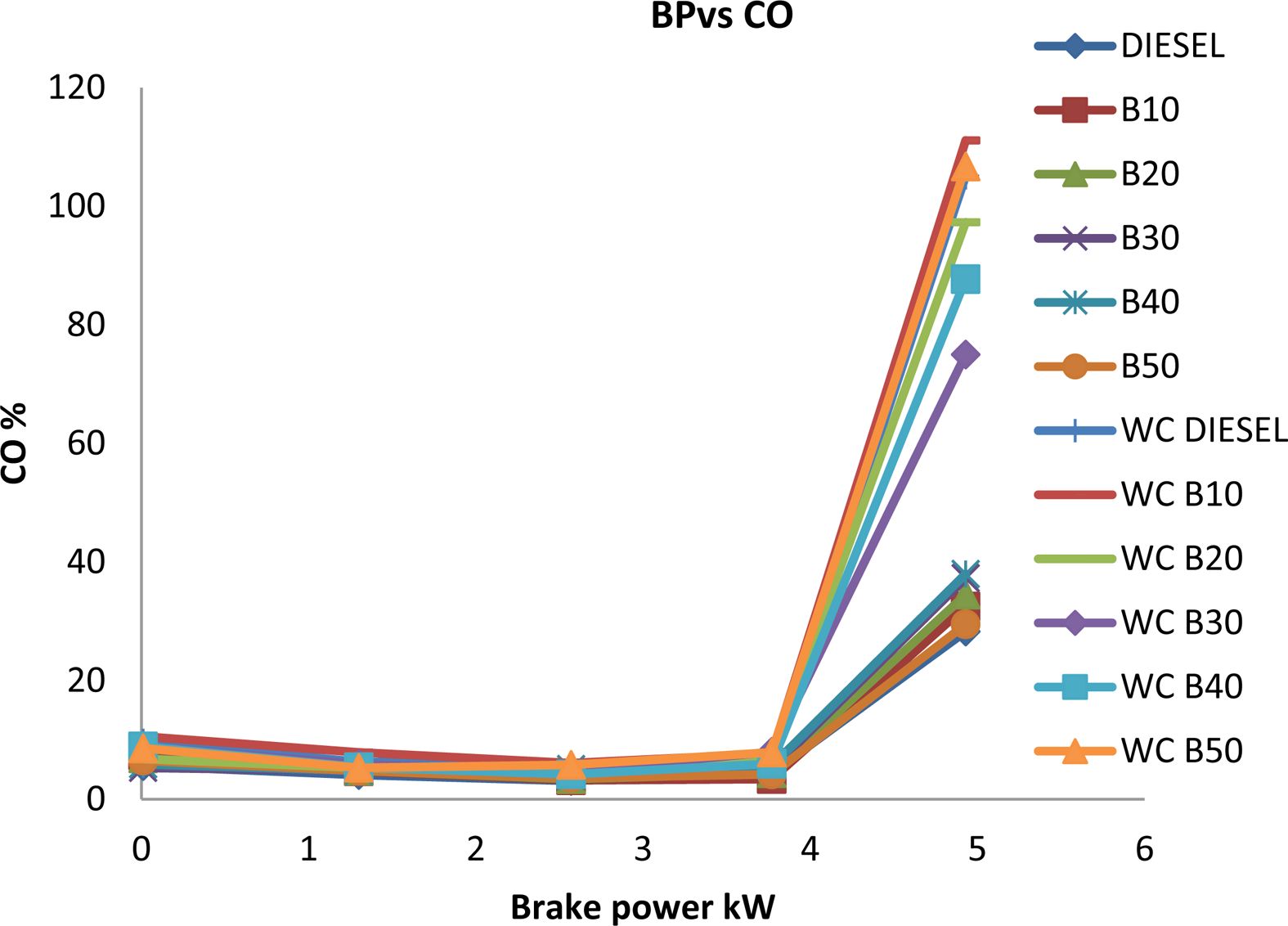
|
Fig. 11 Comparison of CO emission vs BP |
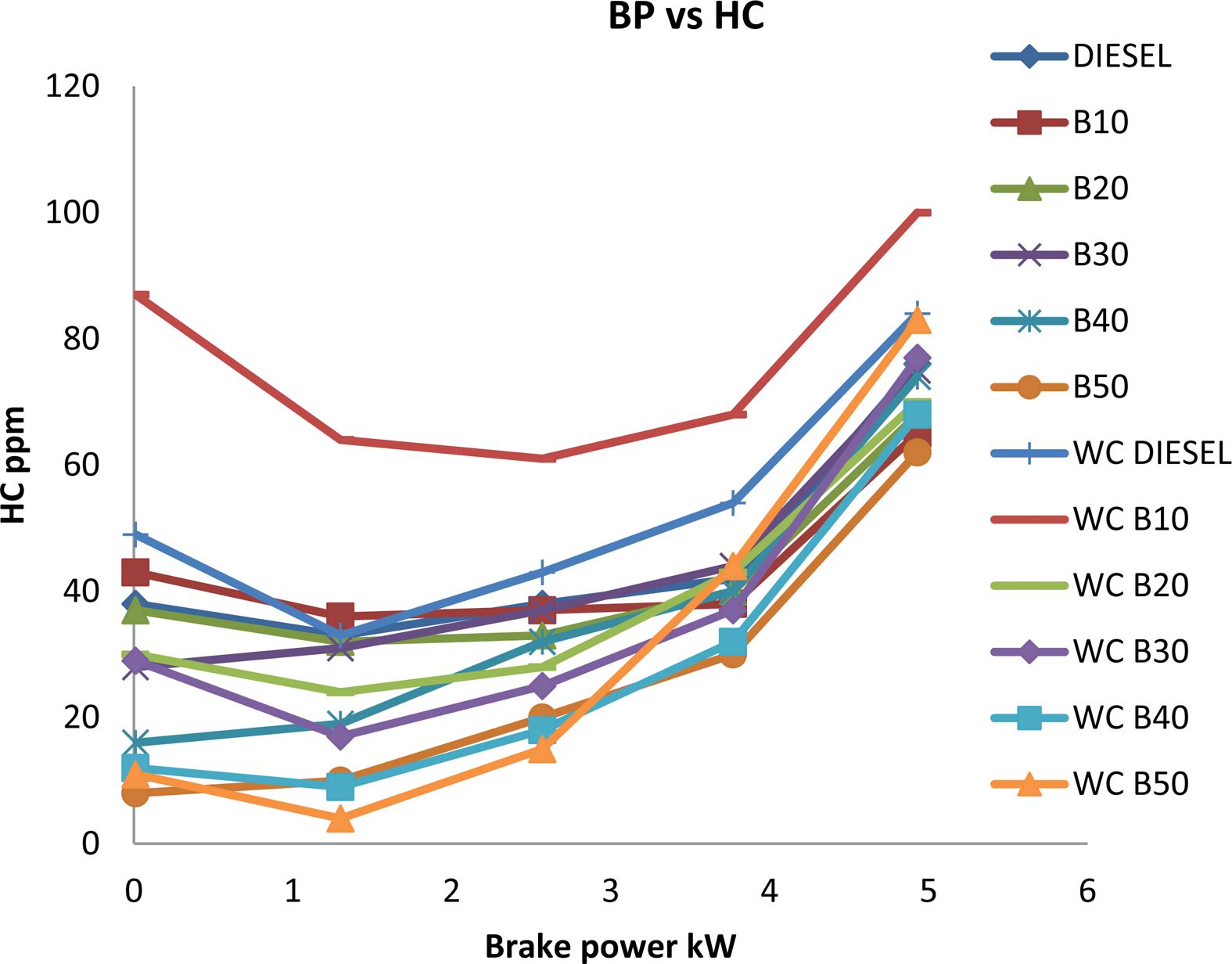
|
Fig. 12 Comparison of HC vs BP. |
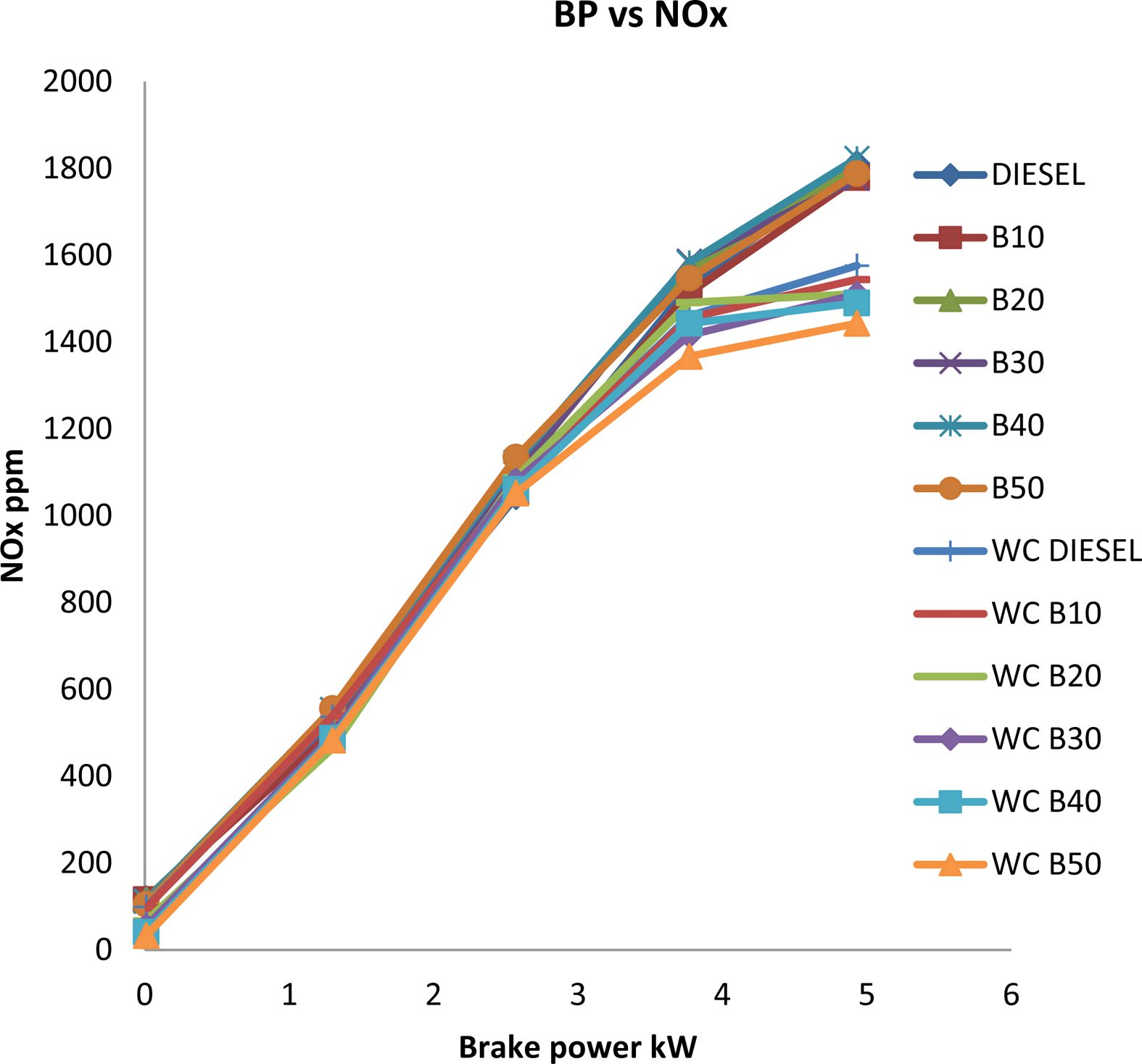
|
Fig. 13 Comparison of NOx emission vs BP. |
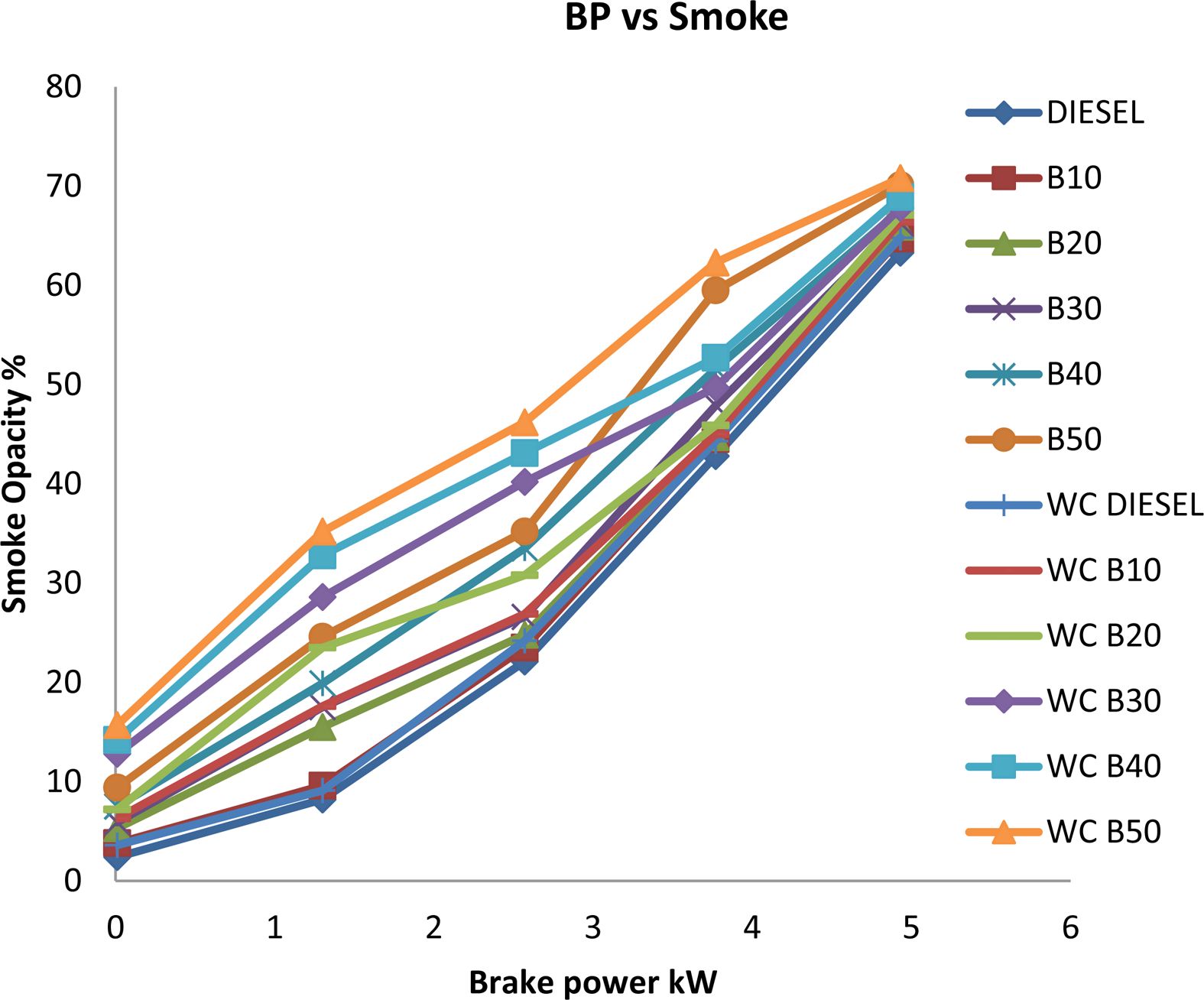
|
Fig. 14 Comparison of Smoke Opacity vs BP. |
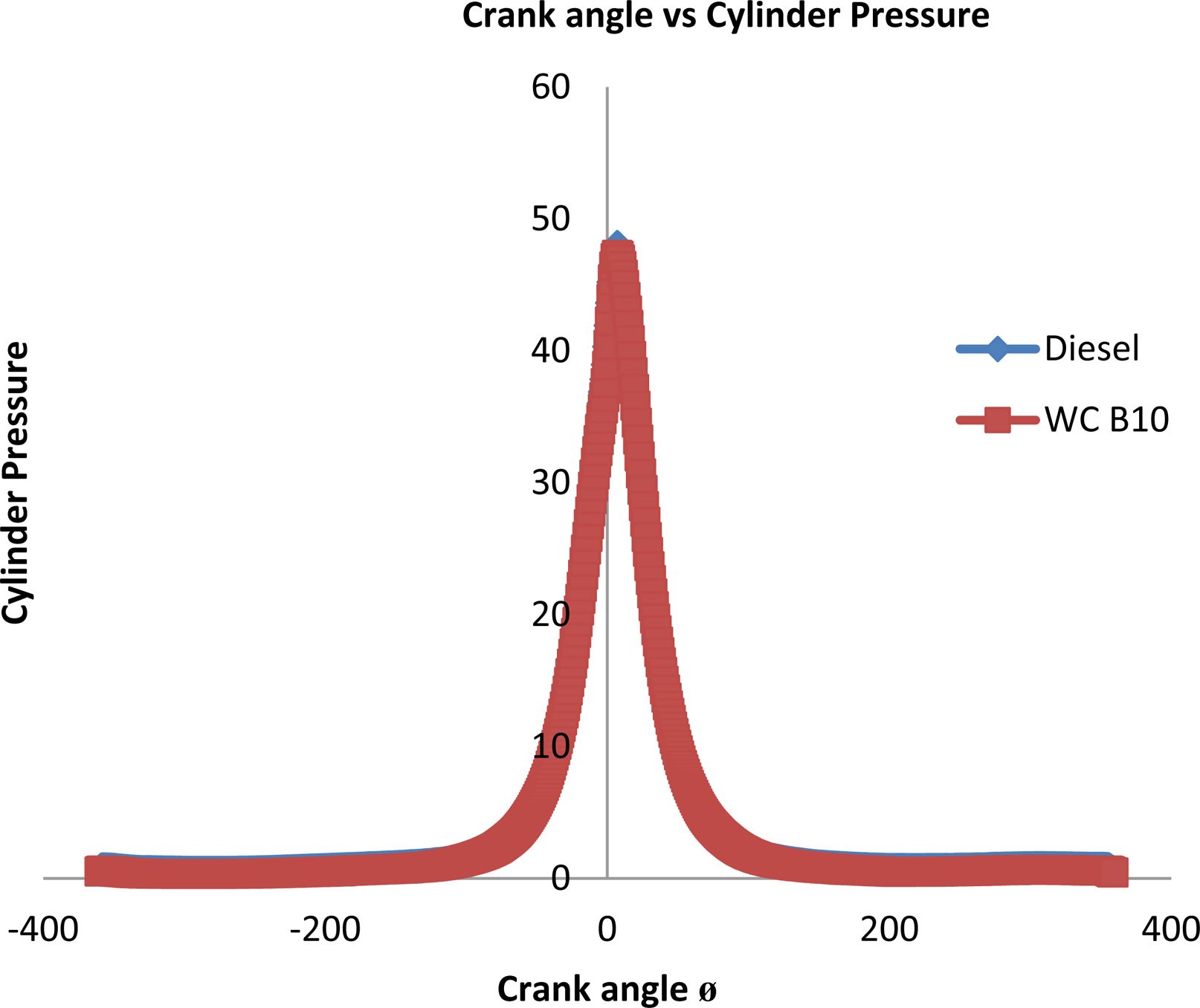
|
Fig. 15 Comparison of crank angle vs cylinder pressure. |
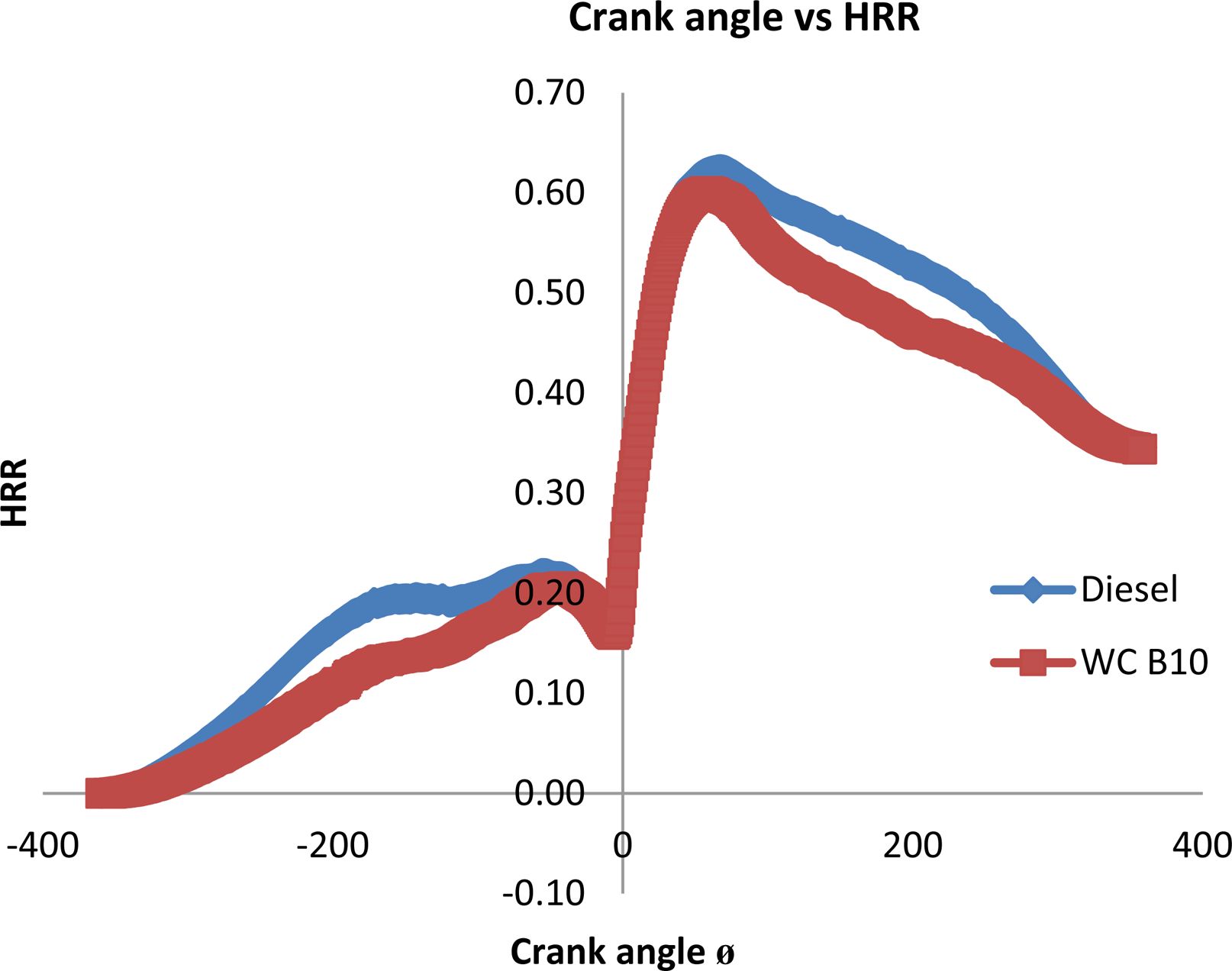
|
Fig. 16 Comparison of crank angle vs HRR. |
In this investigation conducted in the engine performance characteristics and engine emission characteristics of Tungsten Carbide Ceramic Material coated engine fuelled with PJME blends were compared. The Tungsten Carbide Ceramic Material coated engine components for piston head and inlet and exhaust valve head, coating thickness is 300 micron using thermal barrier coating method. The result is reviled at the brake power, BSFC is analyzed for engine performance and HC, CO, NOx, Smoke opacity are analyzed for the emission characteristics. The PJME blended produces best results when compared with, Tungsten Carbide Ceramic Material coated engine fuelled with WC B10 blends were compared to diesel. The higher level of brake thermal efficiency is observed with B10 it is found to be 32.58%, while the brake thermal efficiency of coated engine WC B10 is 33.13%, the diesel fuel at maximum load 33.87%. The brake specific fuel consumption in favor of the B10 is initiated to be 0.27 kg/kWh under engine WC B10 is 0.26 kg/kWh full load conditions and it is the economic value. The CO emission for the diesel fuel is found to be 28.3% whereas the CO emission for the PJME blend B10 is 32.5%. Finally, the ceramic coating gives better performance in terms of mechanical properties and emission characteristics.
- 1. M. Kuppusamy and T. Ramanathan, Mater Technol. 55[1] (2021) 121-126.
-

- 2. M. Yao, T. Ma, H. Wang, Z. Zheng, H. Liu, and Y. Zhang, Energy 162 (2018) 744-752.
-

- 3. J.M. Marchetti, V.U. Miguel, and A.F. Errazu, Renew. Sustain. Energy Rev. 11[6] (2007) 1300-1311.
-

- 4. A.G. Kevin, L. Zhao, and M. Emptage, Curr. Opin. Chem. Biol. 10[2] (2006) 141-146.
-

- 5. L. Odling-Smee, Nature 446[7135] (2007) 483-483.
-

- 6. A.P. Sathiyagnanan, C.G. Saravanan, and S. Dhandapani, In Proceedings of the world Congress on Engi. 2 (2010) 1-4.
- 7. M. Mourshed, S.K. Ghosh, and M.W. Islam, Int. J. Ambient Ene. 43[1] (2021) 1772-1782.
-

- 8. K. Masera and A.K. Hossain, J. Energy Inst. 92[3] (2019) 783-801.
-

- 9. J.W. Lee, C.H. Lee, and H.J. Kim, J. Ceram. Process. Res. 2[3] (2001) 113-119.
- 10. N.R. Banapurmath, P.G. Tewari, and R.S. Hosmath, Renew. Energy 33[9] (2008) 1982-1988.
-

- 11. A.S. Kumar, S. Yuvaraj, and S. Janaki, J. Ceram. Process. Res. 21[2] (2020) 217-225.
-

- 12. P.Q. Tan, Y.M. Zhong, Z.Y. Hu, and D.M. Lou, Energy 141 (2018) 898-906.
-

- 13. M.M. Shivashimpi, S.A. Alur, S.N. Topannavar, and B.M. Dodamani, Energy 154 (2018) 17-26.
-

- 14. V. Manieniyan, R. Senthilkumar, and V. Sukumar, Mater. Today: Proc. 37 (2021) 3665-3672.
-

- 15. N. Yilmaz, E. Ileri, and A. Atmanli, Int. J. Energy Res. 40[8] (2016) 1134-1143.
-

- 16. J. Moon, H. Choi, and C. Lee, J. Ceram. Process. Res. 1[1] (2000) 69-73.
- 17. K. Nanthagopal, B. Ashok, A. Tamilarasu, A. Johny, and A. Mohan, Energy Convers. Man. 146 (2017) 8-19.
-

- 18. A. Bilgin, O. Durgun, and Z. Sahin, Energy Sources 24[5] (2002) 431-440.
-

- 19. A. Nalgundwar, B. Paul, and S.K. Sharma, Fuel 173 (2016) 172-179.
-

- 20. Y.H. Tan, M.O Abdullah, C. Nolasco-Hipolito, N.S.A Zauzi, and G.W. Abdullah, Energy Convers. Man. 132 (2017) 54-64.
-

- 21. C. Ozturk and T. Demircan, J. Ceram. Process. Res. 21[4] (2020) 433-441.
-

- 22. J. Dharmaraja, D.D. Nguyen, S. Shobana, G.D. Saratale, S. Arvindnarayan, A.E. Atabani, S.W. Chang, and G. Kumar, Fuel 239 (2019) 153-161.
-

- 23. A. Sharma, Y. Singh, and N.A. Kumar, Energ Source Part A 41[24] (2019) 3046-57.
-

- 24. M. Kuppusamy and T. Ramanathan, Mater Technol. 55[4] (2020) 509-515.
-

- 25. H.C. Ong, H.H. Masjuki, T.I. Mahlia, A.S. Silitonga, W.T. Chong, and T. Yusaf, Energy 69 (2014) 427-445.
-

- 26. Ganesan, K. Murugan, R. Prakash, and N. Kathiravan, J. Ceram. Process. Res. 23[5] (2022) 625-628.
-

- 27. P. Mohan Kumar, V.C. Uvaraja, and P. Madhu, J. Ceram. Process. Res. 23[5] (2022) 647-655.
-

 This Article
This Article
-
2023; 24(1): 158-163
Published on Feb 28, 2023
- 10.36410/jcpr.2023.24.1.158
- Received on Aug 23, 2022
- Revised on Sep 23, 2022
- Accepted on Nov 3, 2022
 Services
Services
Shared
 Correspondence to
Correspondence to
- S. Kannan
-
Facutly of Mechanical Engineering, AVS College of Technology, Salem, India – 636106
Tel : +91 9789660209 - E-mail: kannannext@gmail.com






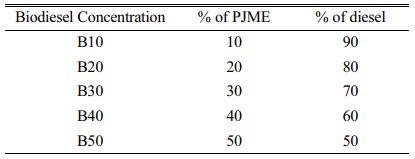
 Copyright 2019 International Orgranization for Ceramic Processing. All rights reserved.
Copyright 2019 International Orgranization for Ceramic Processing. All rights reserved.